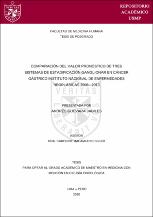Comparación del valor pronóstico de tres sistemas de estadificación ganglionar en cáncer gástrico Instituto Nacional de Enfermedades Neoplásicas 2008 - 2013

Ver/
Descargar
(application/pdf: 1.006Mb)
(application/pdf: 1.006Mb)
Fecha
2020Autor(es)
Guevara Jabiles, Andrés
Metadatos
Mostrar el registro completo del ítemResumen
The log odd of positive lymph nodes (LODDS) and the lymph node ratio (LNR) are alternative lymph node (LN) staging systems in cancer staging. Objective: Compare which of the lymph node staging systems has the best predictive value for overall survival in patients with resectable gastric cancer who underwent surgery. Methods: 673 medical records of gastric cancer patients who underwent radical gastrectomy with D2 lymphadenectomy between 2008 and 2013 were retrospectively review in the National Cancer Institute from Peru. The discriminatory ability and prognostic stratification were analyzed with log likelihood, Akaike information criterion (AIC) and the area under the curve (AUC) of the receiver operating characteristic (ROC) curve. Results: 667 (99.1%) patients had more than 15 LN retrieved, 451 (67%) were node-positive and 42 (range 8-153) as median lymph nodes analyzed. The five-year overall survival was 57%. pN, LNR and LODDS resulted as independent prognostic factors for survival in multivariate analysis in each model (p0.001). LODDS showed greater discriminatory ability in all the different subgroups of lymph nodes. There was significant differences in the overall survival among patients with no-lymph node metastasis (pN0 and LNR0), pN2 and pN3a after stratified in LODDS system (p0.05). The predictive value of the pN improved as the number of retrieved lymph node increased. Conclusion: LODDS appears to be the most powerful LN staging system for patients with resectable gastric cancer following radical gastrectomy with D2 lymphadenectomy with high median of lymph nodes harvested.
Colecciones
- Tesis de maestría [562]







